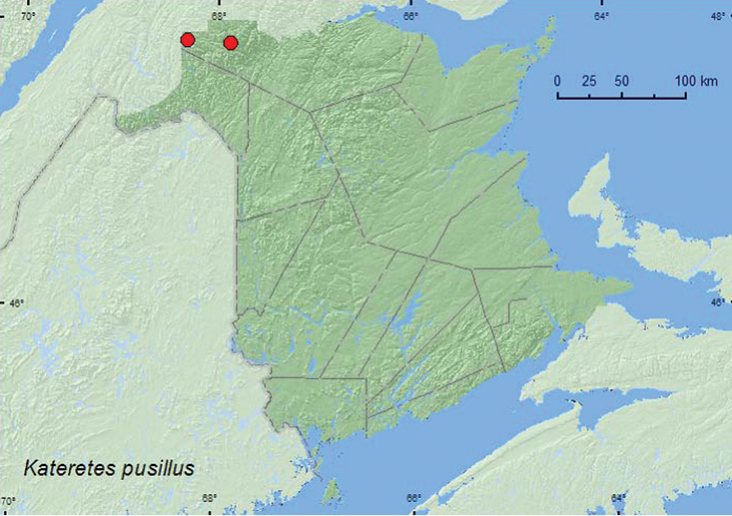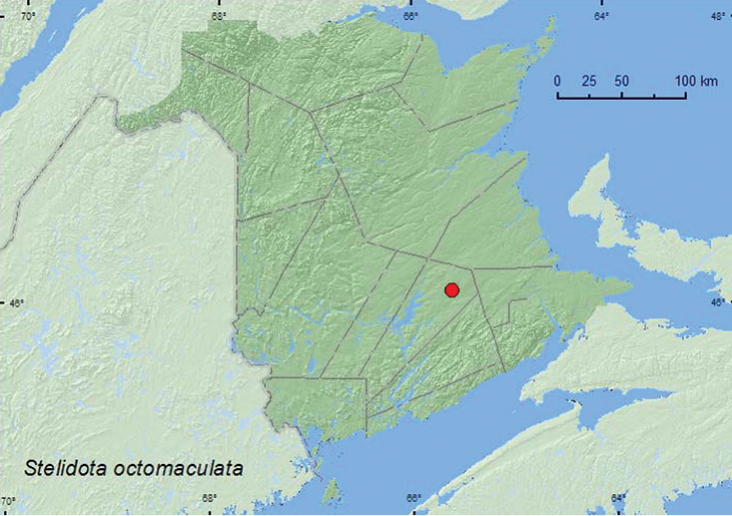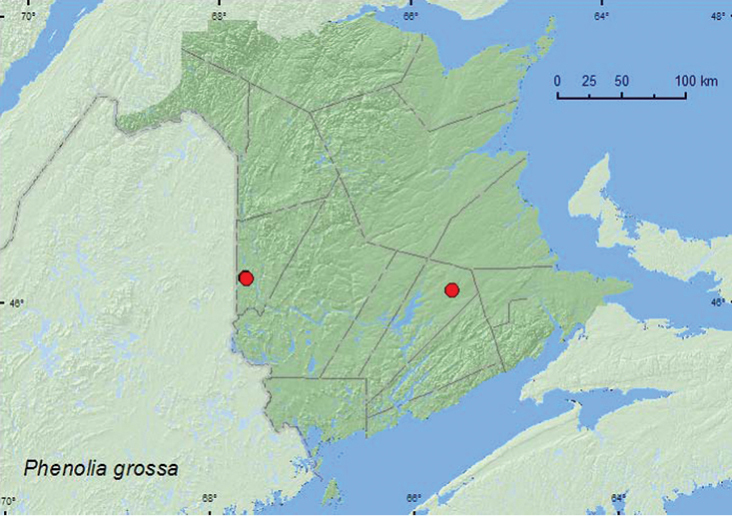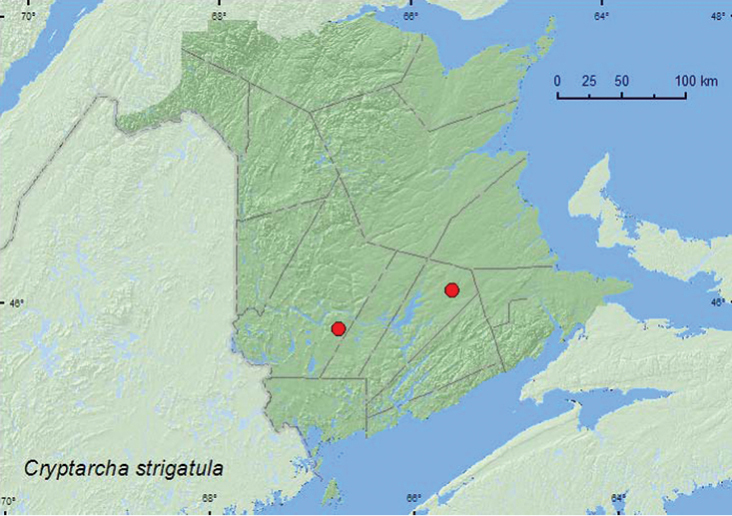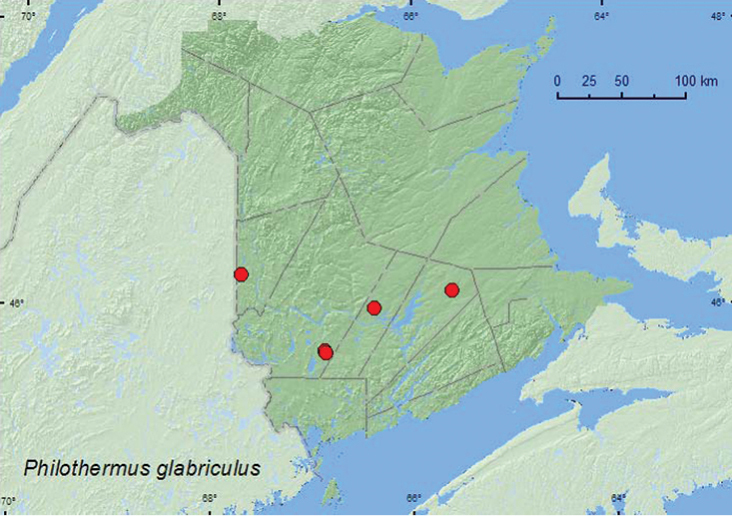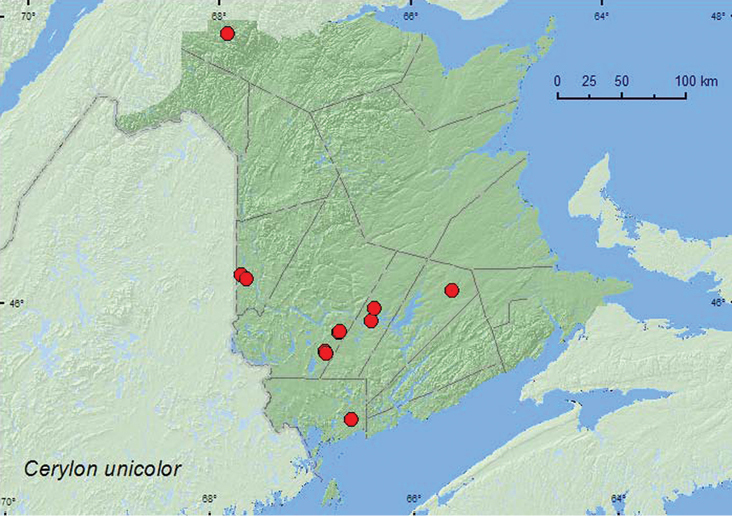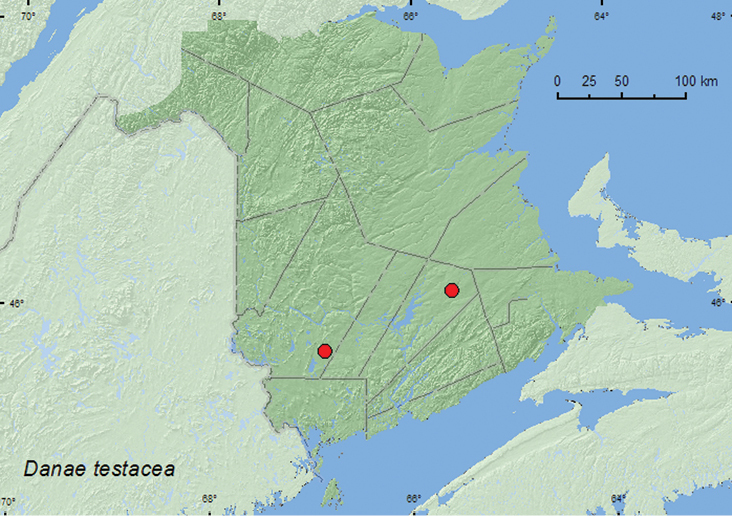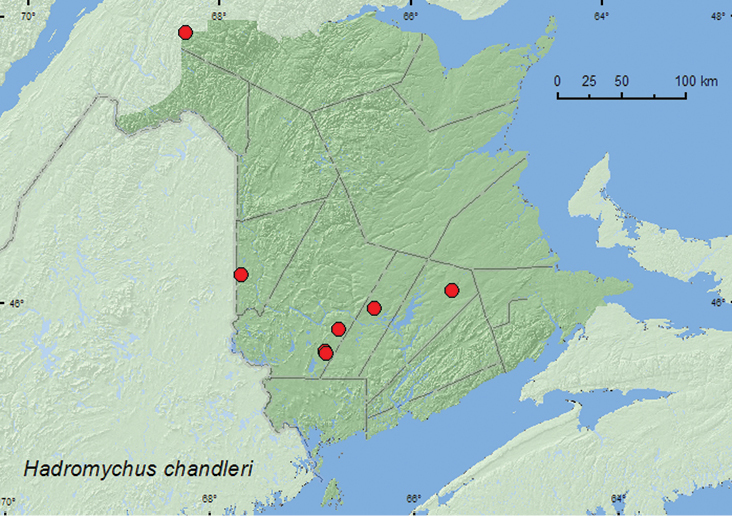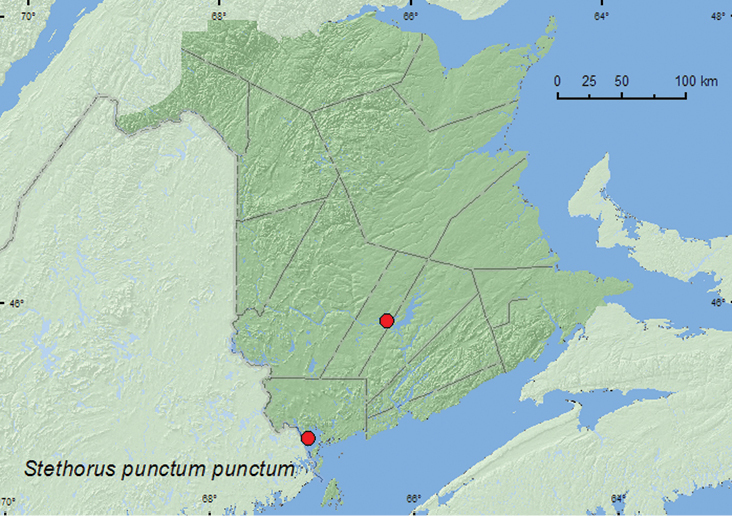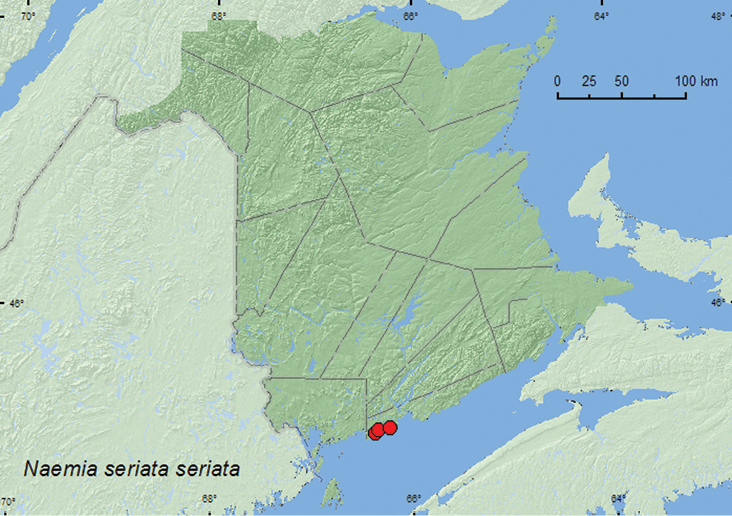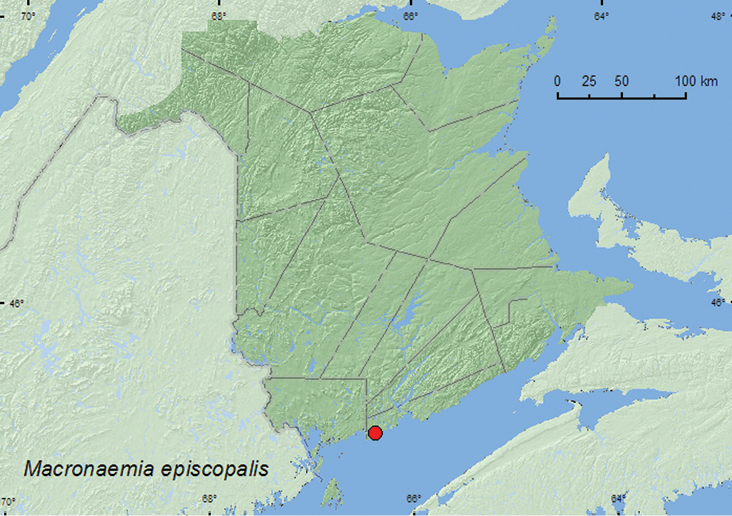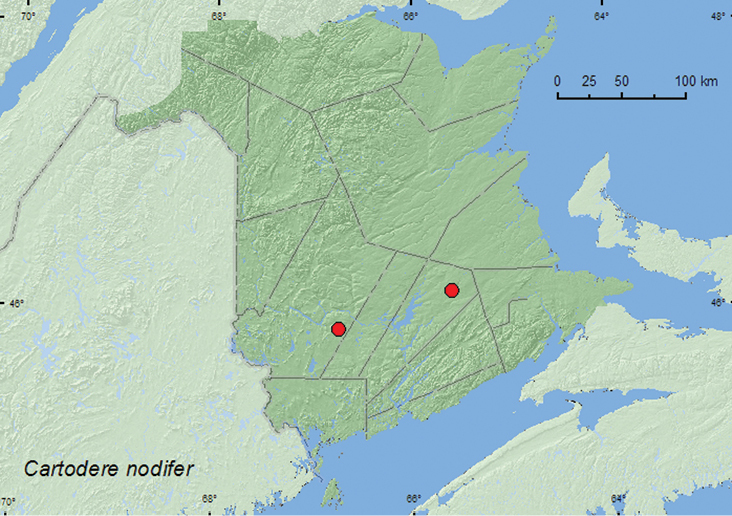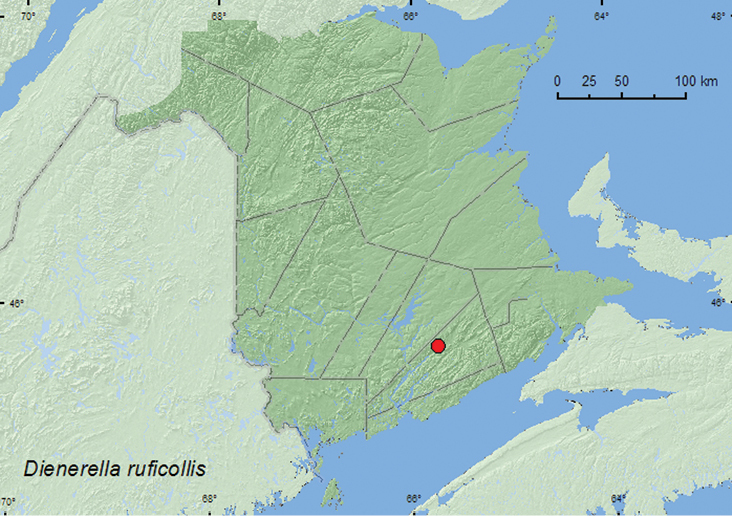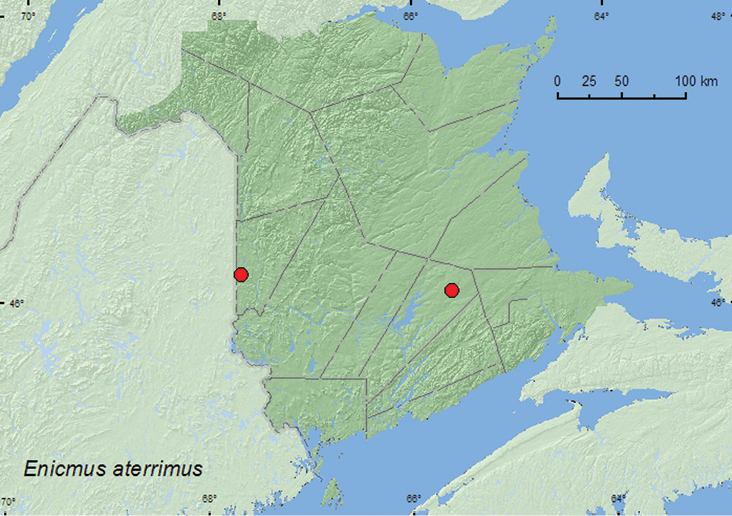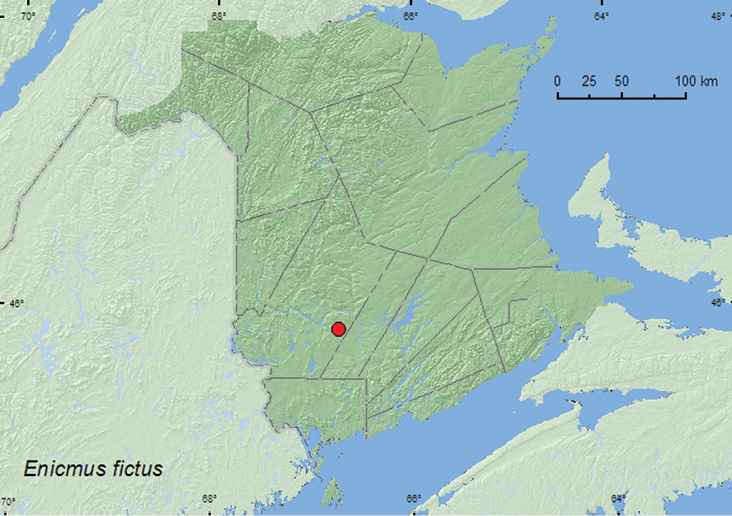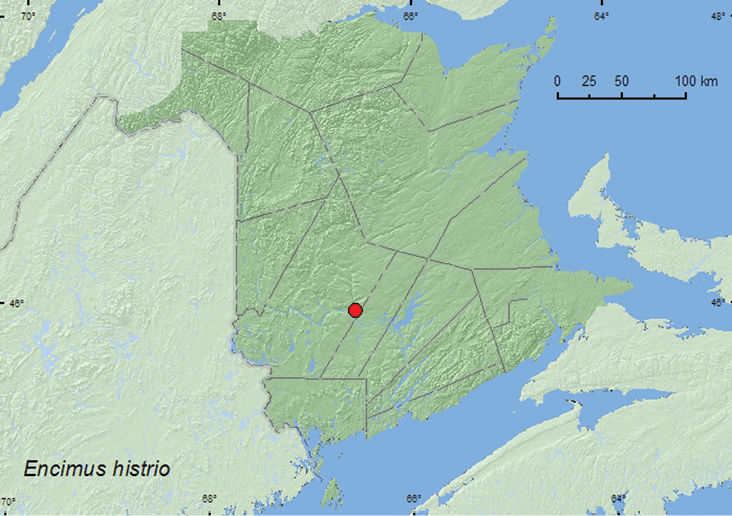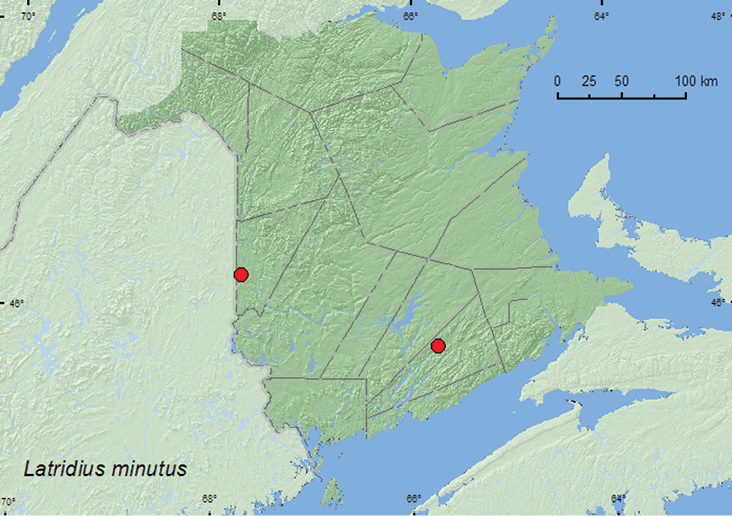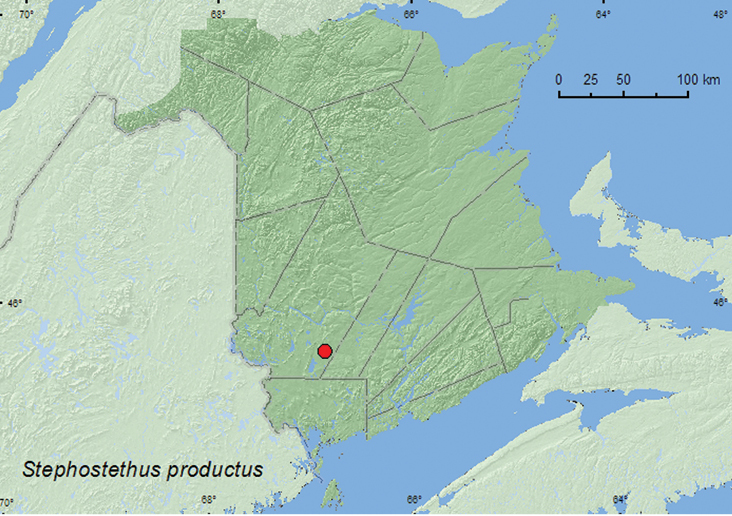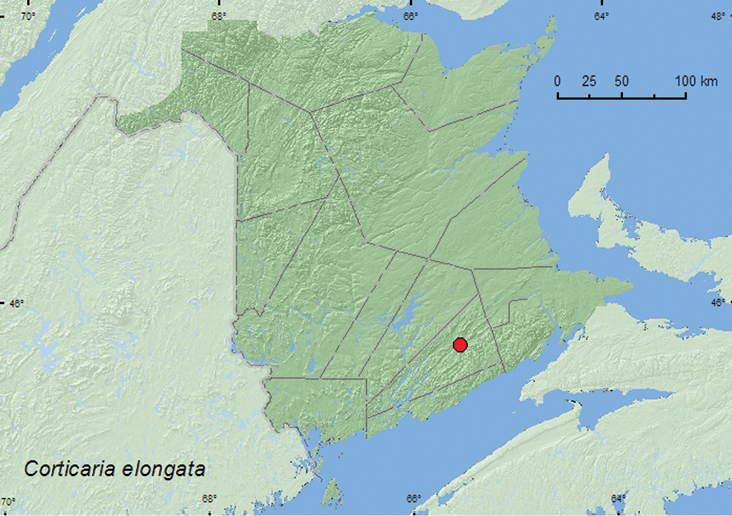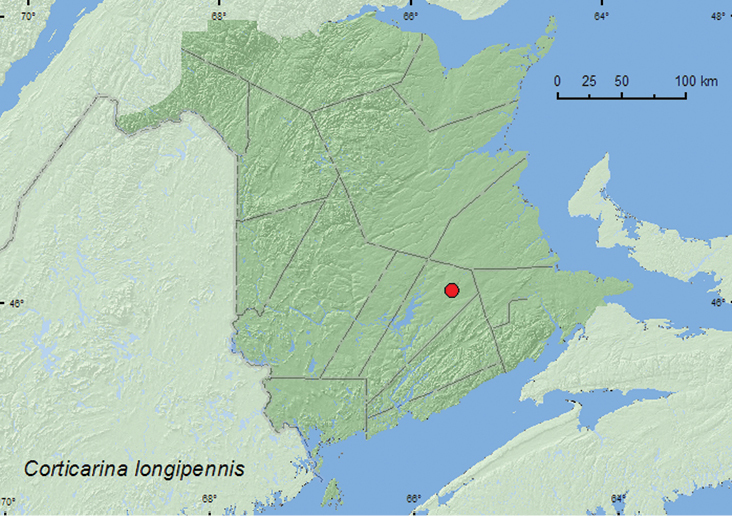






(C) 2012 Reginald P. Webster. This is an open access article distributed under the terms of the Creative Commons Attribution License 3.0 (CC-BY), which permits unrestricted use, distribution, and reproduction in any medium, provided the original author and source are credited.
For reference, use of the paginated PDF or printed version of this article is recommended.
We report 20 new species records for the Coleoptera fauna in New Brunswick, Canada, five of which are new records for the Maritime provinces, including one species that is new for Canada. One species of Kateretidae, Kateretes pusillus (Thunberg) is newly recorded for New Brunswick and the Maritime provinces. Stelidota octomaculata (Say), Phenolia grossa (Fabricius), andCryptarcha strigatula Parsons of the family Nitidulidae are added to the faunal list of New Brunswick; the latter species is new to the Maritime provinces. Two species of Cerylonidae, Philothermus glabriculus LeConte and Cerylon unicolor (Ziegler), are reported for the first time for New Brunswick. Philothermus glabriculus is new for the Maritime provinces. Two species of Endomychidae, Hadromychus chandleri Bousquet and Leschen and Danae testacea (Ziegler) are newly recorded for New Brunswick. Three species of Coccinelidae, Stethorus punctum punctum (LeConte), Naemia seriata seriata Melsheimer, and Macronaemia episcopalis (Kirby) are added to the provincial list. Macronaemia episcopalis (Kirby) is a species new to the Maritime provinces. Nine species of Latridiidae, Cartodere nodifer (Westwood), Dienerella ruficollis (Marsham), Enicmus aterrimus Motschulsky, Enicmus fictus Fall, Encimus histrio Jay and Tomlin, Lathridius minutus (Linnaeus), Stephostethus productus Rosenhauer, Corticaria elongata (Gyllenhal), and Corticarina longipennis (LeConte) are newly recorded for New Brunswick. Stephostehus productus is newly recorded from Canada. Collection and habitat data are presented for all these species.
Cerylonidae, Coccinellidae, Endomychidae, Kateretidae, Latridiidae, Nitidulidae, new records, Canada, New Brunswick
This paper treats new records from New Brunswick, Canada of the Coleoptera families Kateretidae, Nitidulidae, Cerylonidae, Endomychidae, Coccinellidae, and Latridiidae. The fauna of these families from New Brunswick and the Maritime provinces (New Brunswick, Nova Scotia, and Prince Edward Island) was recently treated by
The following records are based on specimens collected during a general survey by the first author to document the Coleoptera fauna of New Brunswick and from by-catch samples obtained during a study to develop a general attractant for the detection of invasive species of Cerambycidae. Additional records were obtained from specimens contained in the collection of the Natural Resources Canada, Canadian Forest Service - Atlantic Forestry Centre, Fredericton, New Brunswick.
Collection methodsVarious methods were employed to collect the specimens and details are outlined in
Distribution maps, created using ArcMap and ArcGIS, are presented for each species in New Brunswick. Every species is cited with its currently known distribution in Canada and Alaska, using abbreviations for the state, provinces, and territories. New records for New Brunswick are indicated in bold under Distribution in Canada and Alaska. The following abbreviations are used in the text:
| AK | Alaska | MB | Manitoba |
| YT | Yukon Territory | ON | Ontario |
| NT | Northwest Territories | QC | Quebec |
| NU | Nunavut | NB | New Brunswick |
| BC | British Columbia | PE | Prince Edward Island |
| AB | Alberta | NS | Nova Scotia |
| SK | Saskatchewan | NF & LB | Newfoundland and Labrador* |
*Newfoundland and Labrador are each treated separately under the current Distribution in Canada and Alaska.
Acronyms of collections examined or where voucher specimens reside are as follows:
AFC Atlantic Forestry Centre, Natural Resources Canada, Canadian Forest Service, Fredericton, New Brunswick, Canada
CNC Canadian National Collection of Insects, Arachnids and Nematodes, Agriculture and Agri-Food Canada, Ottawa, Ontario, Canada
MTC Martin Turgeon Collection, Saint Basil, New Brunswick, Canada
NBM New Brunswick Museum, Saint John, New Brunswick, Canada
RWC Reginald P. Webster Collection, Charters Settlement, New Brunswick, Canada
Results Species accountsAll records below are species newly recorded for New Brunswick, Canada. Species followed by ** are newly recorded from the Maritime provinces of Canada. Species followed by *** are newly recorded for Canada.
Family Kateretidae Kirby, 1837The Kateretidae (the short-winged flower beetles) are phytophagous both as larvae and adults (
Species of Kateretidae, Cerylonidae, Endomychidae, and Latridiidae known from New Brunswick, Canada.
| Kateretidae Kirby |
| Brachypterolus pulicarius (Linnaeus) |
| Brachypterus urticae (Fabricius) |
| Heterhelus abdominalis (Erichson) |
| Heterhelus sericans (LeConte) |
| Kateretes pusillus (Thunberg)** |
| Family Cerylonidae Billberg |
| Subfamily Ceryloninae Billberg |
| Cerylon castaneum Say |
| Cerylon unicolor (Ziegler)* |
| Philothermus glabriculus LeConte** |
| Family Endomychidae Leach |
| Subfamily Endomychinae Leach |
| Endomychus biguttatus Say |
| Subfamily Epipocinae Gorham |
| Hadromychus chandleri Bousquet & Leschen* |
| Subfamily Leiestinae Thomson |
| Phymaphora pulchella Newman |
| Subfamily Lycoperdininae Bromhead |
| Lycoperdina ferruginea LeConte |
| Mycetina perpulchra (Newman) |
| Subfamily Stenotarsinae Chapuis |
| Danae testacea (Ziegler)* |
| Family Latridiidae Erichson |
| Subfamily Latridiinae Erichson |
| Cartodere (Cartodere) constrcta (Gyllenhal) |
| Cartodere (Aridius) nodifer (Westwood)* |
| Dienerella argus (Reitter) |
| Dienerella ruficollis (Marsham)* |
| Enicmus aterrimus Motschulsky* |
| Enicmus fictus Fall** |
| Enicmus histrio Joy & Tomlin* |
| Enicmus tenuicornis LeConte |
| Lathridius consimilis (Mannerheim) |
| Lathridius minutus (Linnaeus)* |
| Stephostethus breviclavis (Fall) |
| Stephostethus litratus (LeConte) |
| Stephostethus productus Rosenhauer*** |
| Thes bergrothi (Reitter) |
| Subfamily Cortcarinae Curtis |
| Corticaria elongata (Gyllenhal)* |
| Corticaria ferruginea Marsham |
| Corticaria impressa (Olivier) |
| Corticaria rubripes Mannerheim |
| Corticaria saginata Mannerheim |
| Corticarina cavicollis (Mannerheim) |
| Corticarina longipennis (LeConte)* |
| Corticarina minuta (Fabricius) |
| Cortinicara gibbosa (Herbst) |
| Melanophthalma helvola Motschulsky |
| Melanophthalma inermis Motschulsky |
| Melanophthalma picta (LeConte) |
Notes: *New to province, **New to Maritime provinces, *** New to Canada.
New Brunswick, Restigouche Co., Wild Goose Lake, 47.8539°N, 68.3219°W, 7.VI.2011, 20.VI.2011, R. Webster & M. Turgeon, lake margin, Carex marsh, treading Carex (21, AFC, MTC, NBM, RWC); Kedgwick Road at Fog Brook, 47.8367°N, 67.8739°W, 21.VI.2011, R. P. Webster, Carex marsh near brook, treading Carex (2, NBM, RWC).
Collection localities in New Brunswick, Canada of Kateretes pusillus.
Adults of this northern species were collected by treading (forcing emergent vegetation into water) Carex in Carex marshes along a lake margin and a brook. At both sites where this species was found, Carex was covered with pollen. Adults were captured during June. Specimens of this species in the Carr collection in the CNC were collected by sweeping or sieving sedges in beaver (Castor canadensis Kuhl.) ponds, marshes, bogs, dried boggy areas, small muskegs, sedge marshes, swamps, in sphagnum and moss at the edge of a sedge marsh, in wash-up along a river, and by sifting willow (Salix)/poplar (Populus) leaves on a slope around a marsh (Anthony Davies, personal communication).
AK, NT, AB, SK, ON, QC, NB (
The Nitidulidae (the sap beetles) is a large family of mostly saprophagous and mycetophagous species (
New Brunswick, Queens Co., Cranberry Lake P.N.A (Protected Natural Area), 46.1125°N, 65.6075°W, 2.IX.2009, R. Webster & M.-A. Giguère, old red oak forest, in nest of black Formica species (mound building species) (1, RWC); same locality data and forest type, 31.VIII–15.IX.2011, C. Hughes & R. P. Webster, Lindgren funnel traps (2, RWC).
Collection localities in New Brunswick, Canada of Stelidota octomaculata.
Stelidota octomaculata has been reported from decaying fruit and fungi, coral fungi (
ON, QC, NB, NS (
New Brunswick, Carleton Co., Meduxnekeag Valley Nature Preserve, 46.1940°N, 67.6801°W, 12.IX.2008, R. P. Webster, mixed forest, in Laetiporus sulphureus (3, RWC); same locality but 46.1887°N, 67.6735°W, 13.VI.2010, R. P. Webster, hardwood forest, in Laetiporus sulphureus (8, NBM, RWC). Queens Co., Cranberry Lake P.N.A, 46.1125°N, 65.6075°W, 7.VI-22.VI.2011, M. Roy & V. Webster, old red oak forest, Lindgren funnel trap (1, NBM); same locality data and forest type, 4.VIII.2011, 18.VIII.2011, R. P. Webster, in Laetiporus sulphureus (5, AFC, NBM, RWC).
Collection localities in New Brunswick, Canada of Phenolia grossa.
ON, QC, NB, NS (
Tribe Cryptarchini Thomson, 1859
New Brunswick, Queens Co., Cranberry Lake P.N.A, 46.1125°N, 65.6075°W, 7-22.VI.2011, M. Roy & V. Webster, mature red oak forest, Lindgren funnel traps (2, RWC). Charters Settlement, 45.8395°N, 66.7391°W, 20.VII.2006, 1.VIII.2007, R. P. Webster, mixed forest, m.v. light (2, RWC).
Collection localities in New Brunswick, Canada of Cryptarcha strigatula.
This species was captured in Lindgren funnel traps deployed in an old red oak forest and at a mercury-vapor light near a mixed forest. Adults were collected during June, July, and August.
ON, QC, NB. There are two specimens in the CNC from Canada with the following data: Ont: Leeds County, Leeds and Lansdowne Township, 17.VIII.1992, Quercus alba under bark; Que: Co. Iberville, Rivière du Sud, 30.VII.1975, N. Doiron, CH308 (Anthony Davies, personal communication).
North American species of Cerylonidae (the minute bark beetles) were revised by
New Brunswick, Carleton Co., Jackson Falls, Bell Forest, 46.2200°N, 67.7231°W, 4-12.VI.2008, R. P. Webster, mature hardwood forest, Lindgren funnel traps (2, AFC, NBM). Queens Co., Cranberry Lake P.N.A., 46.1125°N, 65.6075°W, 25.VI-1.VII.2009, R. Webster & M.-A. Giguère, mature red oak forest, Lindgren funnel trap (1, RWC); same locality and habitat data, 7-22.VI.2011, 29.VI-7.VII.2011, 7-13.VII.2011, M. Roy & V. Webster, Lindgren funnel traps (7, AFC, NBM, RWC). Sunbury Co., Acadia Research Forest, 45.9866°N, 66.3841°W, 24-30.VI.2009, R. Webster & M.-A. Giguère, mature (110 year-old) red spruce forest with scattered red maple and balsam fir, Lindgren funnel trap (1, RWC). York Co., 15 km W of Tracy off Rt. 645, 45.6848°N, 66.8821°W, 7-14.VII.2010, R. Webster & C. MacKay, old red pine forest, Lindgren funnel trap (1, RWC); 14 km WSW of Tracy, S of Rt. 645, 45.6741°N, 66.8661°W, 16-30.VI.2010, R. Webster & C. MacKay, old mixed forest with red and white spruce, red and white pine, balsam fir, eastern white cedar, red maple, and Populus sp., Lindgren funnel trap (1, AFC).
Collection localities in New Brunswick, Canada of Philothermus glabriculus.
Philothermus glabriculus was collected in various forest types in New Brunswick, including a mature hardwood forest with American beech, sugar maple, white ash, a mature red oak forest, a mature red spruce (Picea rubens Sarg.) forest, an old red pine (Pinus resinosa Ait.) forest, and an old mixed forest. Adults were captured in Lindgren funnel traps during June and July.
ON, QC, NB (
New Brunswick, Carleton Co., Jackson Falls, Bell Forest, 46.2200°N, 67.7231°W, 6.V.2007, R. P. Webster, mature hardwood forest, on fleshy polypore (bracket) fungi on dead standing beech (1, RWC); same locality and forest type but 1-8.VI.2009, 16-21.VI.2009, 21-28.VI.2009, 7-14.VII.2009, R. Webster & M.-A. Giguère, Lindgren funnel traps (4, AFC, RWC); Meduxnekeag Valley Nature Preserve, 46.1907°N, 67.6740°W, 7.VI.2007, R. P. Webster, hardwood forest, under bark of sugar maple log (1, RWC). Charlotte Co., 10 km NW of New River Beach, 45.2110°N, 66.6170°W, 15-29.VI.2010, R. Webster & C. MacKay, old growth eastern white cedar forest, Lindgren funnel trap (1, AFC). Queens Co., Cranberry Lake P.N.A., 46.1125°N, 65.6075°W, 5-11.VI.2009, 25.VI-1.VII.2009, R. Webster & M.-A. Giguère, mature red oak forest, Lindgren funnel trap (2, NBM, RWC). Restigouche Co., Kedgwick Forks, 47.9085°N, 67.9057°W, 22.VI.2010, river margin, in flood debris (1, NBM). Sunbury Co., Portobello Creek N.W.A., Maugerville, 45.8990°N, 66.4200°W, 28.VI.2004, R. P. Webster, silver maple swamp, under bark of log (1, RWC); Acadia Research Forest, 45.9866°N, 66.3841°W, 16-24.VI.2009, 24-30.VI.2009, R. Webster & M.-A. Giguère, mature (110 year-old) red spruce forest with scattered red maple and balsam fir, Lindgren funnel traps (5, AFC). York Co., Charters Settlement, 45.8188°N, 66.7460°W, 25.VIII.2004, R. P. Webster, clear-cut, under bark of conifer stump (3, RWC); same locality but 45.8286°N, 66.7365°W, 2.VI.2007, R. P. Webster, mature red spruce forest, under bark of red spruce (1, RWC); 15 km W of Tracy off Rt. 645, 45.6848°N, 66.8821°W, 15-21.VI.2009, R. Webster & M.-A. Giguère, old red pine forest, Lindgren funnel traps (2, AFC); 14 km WSW of Tracy, S of Rt. 645, 45.6741°N, 66.8661°W, 10-26.V.2010, R. Webster & C. MacKay, old mixed forest with red and white spruce, red and white pine, balsam fir, eastern white cedar, red maple, and Populus sp., Lindgren funnel trap (1, AFC).
Collection localities in New Brunswick, Canada of Cerylon unicolor.
In Nova Scotia, this species was found in red spruce stands on Fomitopsis officinalis (Fr.) Bond. & Sing., in an old-growth hemlock (Tsuga canadensis (L.) Carr.) forest, and in a mixed old-growth hemlock, black spruce (Picea mariana (Mill.) B.S.P.), and balsam fir (Abies balsamea (L.) Mill.) stand (
NT, BC, AB, ON, QC, NB, NS, NF (
The Endomychidae (handsome fungus beetles) are found in subcortical fungi, soft polypores, fleshy basidiomycetes, and various molds and mildews or are specialists on puffballs (Lycoperdina ferruginea LeConte) (
http://species-id.net/wiki/Hadromychus_chandleri
Map 7New Brunswick, Carleton Co., Jackson Falls, Bell Forest, 46.2200°N, 67.7231°W, 4-12.VI.2008, 12-19.VI.2008, R. P. Webster, mature hardwood forest, Lindgren funnel traps (5, NBM, RWC); same locality and habitat data, 28.IV-9.V.2009, 9-14.V.2009, 14-20.V.2009, 21-28.VI.2009, R. Webster & M.-A. Giguère, mature hardwood forest, Lindgren funnel traps (8, AFC, RWC). Queens Co., Cranberry Lake P.N.A., 46.1125°N, 65.6075°W, 12-21.V.2009, 21-27.V.2009, 27.V-5.VI.2009, R. Webster & M.-A. Giguère, old red oak forest, Lindgren funnel traps (5, AFC); same locality data and forest type, 25.V-7.VI.2011, M. Roy & V. Webster, Lindgren funnel trap (1, NBM). Restigouche, Co., Dionne Brook P.N.A., 47.9030°N, 68.3503°W, 31.V-15.VI.2011, M. Roy & V. Webster, old-growth northern hardwood forest, Lindgren funnel traps (3, AFC, NBM); same locality and collectors but 47.9064°N, 68.3441°W, 31.V-15.VI.2011, 27.VI-14.VII.2011, old-growth white spruce and balsam fir forest (26, AFC, NBM, RWC). Sunbury Co., Acadia Research Forest, 45.9866°N, 66.3841°W, 28.IV-8.V.2009, 13-19.V.2009, 19-25.V.2009, 2-9.VI.2009, 24-30.VI.2009, R. Webster & M.-A. Giguère, mature (110 year-old) red spruce forest with scattered red maple and balsam fir, Lindgren funnel traps (6, AFC, RWC). York Co., 15 km W of Tracy off Rt. 645, 45.6848°N, 66.8821°W, 4-11.V.2009, 11-19.V.2009, R. Webster & M.-A. Giguère, old red pine forest, Lindgren funnel traps (2, AFC, RWC); 14 km WSW of Tracy, S of Rt. 645, 45.6741°N, 66.8661°W, 26.IV-10.V.2010, 10-26.V.2010, 26.V-2.VI.2010, R. Webster & C. MacKay, old mixed forest with red and white spruce, red and white pine, balsam fir, eastern white cedar, red maple, and Populus sp., Lindgren funnel traps (8, AFC);Charters Settlement, 45.8395°N, 66.7391°W, 1–5.VI.2011, R. P. Webster, mixed forest, flight intercept trap (1, NBM).
Collection localities in New Brunswick, Canada of Danae testacea.
Little is known about the habitat requirements of Hadromychus chandleri. All (64) specimens from New Brunswick were captured in Lindgren funnel traps, which visually mimic tree trunks and are often effective for sampling species of Coleoptera that live in microhabitats associated with standing trees (
ON, QC, NB, NS (
New Brunswick, Queens Co., Cranberry Lake P.N.A., 46.1125°N, 65.6075°W, 14-19.VIII.2009, R. Webster & M.-A. Giguère, old red oak forest, Lindgren funnel trap (1, RWC). York Co., 15 km W of Tracy off Rt. 645, 45.6848°N, 66.8821°W, 29.VI-7.VIII.2009, R. Webster & M.-A. Giguère, old red pine forest, Lindgren funnel trap (1, RWC).
Collection localities in New Brunswick, Canada of Hadromychus chandleri.
Danae testacea was captured in Lindgren funnel traps in an old red oak forest and an old red pine forest. Both individuals of this species were captured during August. The specimen reported from Nova Scotia was found in an old-growth hardwood stand, and
ON, QC, NB, NS (
http://species-id.net/wiki/Stethorus_punctum_punctum
Map 9New Brunswick, Charlotte Co., St. Andrews, 45.0751°N, 67.0374°W, 25.VIII.2009, R. P. Webster, sea beach, sweeping foliage (1, RWC). Sunbury Co., Lakeville Corner, 45.9013°N, 66.2565°W, 27.VIII.2006, R. P. Webster, silver maple forest, on corncobs (1, RWC).
Collection localities in New Brunswick, Canada of Stethorus punctatum punctatum.
This species was collected by sweeping foliage on a sea beach and sifting debris from a pile of corncobs in a silver maple (Acer saccharinum L.) forest. The two adults were captured during August.
AB, SK, ON, QC, NB, NS (
New Brunswick, Saint John Co., Dipper Harbour, 45.1169°N, 66.3771°W, 12.IX.2006, R. P. Webster, salt marsh, on flowers of seaside goldenrod (9 (many others observed), RWC); Chance Harbour off Cranberry Head Road, 45.1355°N, 66.3436°W, 30.V.2006, R. P. Webster, barrier beach, sweeping foliage of Leucanthemum vulgare Lam. (1, RWC); black beach, 45.1539°N, 66.2282°W, 11.VII.2008, R. P. Webster, sea beach, sweeping foliage (1, RWC).
Collection localities in New Brunswick, Canada of Naemia seriata seriata.
Adults were taken by sweeping foliage of ox-eye daisy (Leucanthemem vulgare Lam.) on a barrier beach, sweeping foliage on a sea beach, and sweeping flowers of seaside goldenrod (Solidago sempervirens L.) in a salt marsh. Adults were taken during late May, July, and September.
NB, NS (
New Brunswick, Saint John Co., Dipper Harbour, 45.1169°N, 66.3771°W, 7.V.2006, R. P. Webster, margin of salt marsh, in debris on log (7, RWC); same locality, 12.IX.2006, R. P. Webster, salt marsh, sweeping vegetation (3, NBM, RWC).
Collection localities in New Brunswick, Canada of Macronaemia episcopalis.
Macronaemia episcopalis was collected from salt marshes during September by sweeping foliage and sifting debris on a log in early May. The latter site was probably an overwintering site.
AK, YK, NT, BC, AB, SK, MB, ON, QC, NB (
New Brunswick, Queens Co., Cranberry Lake P.N.A., 46.1125°N, 65.6075°W, 25.VI-1.VII.2009, 21-28.VII.2009, R. Webster & M.-A. Giguère, old red oak forest, Lindgren funnel traps (2, AFC, RWC). York Co., Charters Settlement, 45.8395°N, 66.7391°W, 26.IX.2007, 30.IX.2007, 5.X.2007, 11.X.2007, 18.X.2007, R. P. Webster, mixed forest, in decaying (mouldy) corncobs and cornhusks (9, RWC).
Collection localities in New Brunswick, Canada of Cartodere nodifer.
This adventive species is associated with stored products and has been found in various habitats promoting the growth of molds, such as under bark, in vegetable refuse, haystacks, and leaf compost (
BC, MB, ON, QC, NB, NS, PE (
New Brunswick, Kings Co. Belle Isle (Bellisle Creek), II.18.1981 (no collector given), ex. bulk milk tank (20, AFC).
Collection localities in New Brunswick, Canada of Dienerella ruficollis.
A large series of this adventive Palaearctic species was collected from a bulk milk tank.
BC, ON, QC, NB, NS, NF (
New Brunswick, Carleton Co., Jackson Falls, Bell Forest, 46.2200°N, 67.7231°W, 5-15.VII.2008, R. P. Webster, mature hardwood forest, Lindgren funnel trap (1, NBM). Queens Co., Cranberry Lake P.N.A., 46.1125°N, 65.6075°W, 24.IV-5.V.2009, 5-12.V.2009, 12-21.V.2009, R. Webster & M.-A. Giguère, old red oak forest, Lindgren funnel traps (17, AFC, NBM, RWC).
Collection localities in New Brunswick, Canada of Enicmus aterrimus.
This species was captured in Lindgren funnel traps deployed in an old red oak forest and a mature hardwood forest. Adults were captured during April, May, and July.
ON, QC, NB, NS (
New Brunswick, York Co., Charters Settlement, 45.8395°N, 66.7391°W, 27.VI.2007, R. P. Webster, mixed forest, u.v. light (1 AFC); same locality, habitat, and collector, 23.IV.2008, 9.V.2008, collected during aerial flight 15:00 to 18:00 h (2, RWC); same locality data and collector, 30.IX.2007, 11.X.2007, mixed forest, in decaying (mouldy) corncobs and cornhusks (2, RWC).
Collection localities in New Brunswick, Canada of Enicmus fictus.
This species is often found in stored products and has been collected from grass clippings (
AK, NT, BC, AB, SK, MB, ON, QC, NB, NF (
New Brunswick, York Co., Marysville, 45.9750°N, 66.5700°W, 22.VI.2007, S. Makepeace & R. Webster, from nest material (remains of squirrel, various birds, bones, and insect parts) of barred owl in nest box (2, RWC).
Collection localities in New Brunswick, Canada of Enicmus histrio.
Two individuals of this adventive Palaearctic species were collected from nest material from a barred owl (Strix varia Barton) nest box during June. In the Palaearctic, this species has been found in damp or moldy straw, hay, grass cuttings and vegetable refuse (
NB, NS(
New Brunswick, Carleton Co., Jackson Falls, Bell Forest, 46.2200°N, 67.7231°W , 31.III.2005, R. P. Webster, mature hardwood forest, under bark of standing dead sugar maple (9, RWC); same locality and habitat data, 23-28.IV.2009, R. Webster & M.-A. Giguère, mature hardwood forest, Lindgren funnel traps (2, AFC, RWC). Kings Co., Belle Isle (Bellisle Creek), 18.II.1981, (no collector given) from bulk milk tank (1, AFC).
Collection localities in New Brunswick, Canada of Lathridius minutus.
In New Brunswick, thisadventive Palaearctic species was collected from under bark of a large, standing, dead sugar maple, from a bulk milk tank, and from Lindgren funnel traps deployed in a mature hardwood forest. Adults were captured during February, late March, and April. This species is commonly associated with stored products (
BC, AB, SK, MB, NB, PE, NS, NF (
http://species-id.net/wiki/Stephostethus_productus
Map 18Canada, New Brunswick, York Co., 15 km W of Tracy off Rt. 645, 45.6848°N, 66.8821°W, 8-15.VI.2009, R. Webster & M.-A. Giguère, old red pine forest, Lindgren funnel trap (1, RWC).
Collection localities in New Brunswick, Canada of Stephostethus productus.
One individual of this Palaearctic species was captured in a Lindgren funnel trap in an old red pine forest.
NB (new Canadian record).
New Brunswick, Kings Co., Sussex, 18.IX.1981, (no collector given) from skim milk powder (2, AFC).
Collection localities in New Brunswick, Canada of Corticaria elongata.
Two individuals of this Holarctic or adventive Palaearctic species were collected from skim milk powder. In North America, this species is associated with stored products in grain elevators, warehouses, and feed mills (
NB, NS, NF (
New Brunswick, Queens Co., Cranberry Lake P.N.A., 46.1125°N, 65.6075°W, 21-27.V.2009, R. Webster & M.-A. Giguère, old red oak forest, Lindgren funnel trap (1, RWC).
Collection localities in New Brunswick, Canada of Corticarina longipennis
One specimen was captured in a Lindgren funnel trap deployed in an old red oak forest. The adult was captured during May. Little is known about the habitat requirements of this species.
NB, NS (
We thank Caroline Simpson (AFC) for editing this manuscript. An anonymous reviewer is thanked for many helpful comments that improved this manuscript. Anthony Davies and Yves Bousquet (Agriculture and Agri-Food Canada (CNC), Ottawa) are thanked for determining specimens and other invaluable assistance. Nichole Brawn, Kate Bredin, Katie Burgess, Marie-Andrée Giguère, Jim Edsall, Nancy Harn, Cory Hughes, Colin MacKay, Wayne MacKay, Jessica Price, Michelle Roy, Martin Turgeon, and Vincent Webster are thanked for technical assistance and collecting specimens. Natural Resources Canada, Canadian Forest Service; the Canadian Food Inspection Agency; and the USDA APHIS are thanked for funding the study on early detection of invasive cerambycids, which provided many specimens collected in Lindgren funnel traps. We thank the Canadian Wildlife Service for funding insect surveys at the Portobello Creek National Wildlife Area, the New Brunswick Environmental Trust Fund and the New Brunswick Wildlife Trust Fund for funding various insect surveys over the past 7 years, and the Meduxnekeag River Association for permission to sample beetles at the Meduxnekeag Valley Nature Preserve (which includes the Bell Forest). The New Brunswick Department of Natural Resources (Fish and Wildlife Branch) is thanked for issuing permits for sampling in the Protected Natural Areas and for providing logistical support.
